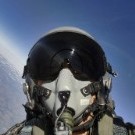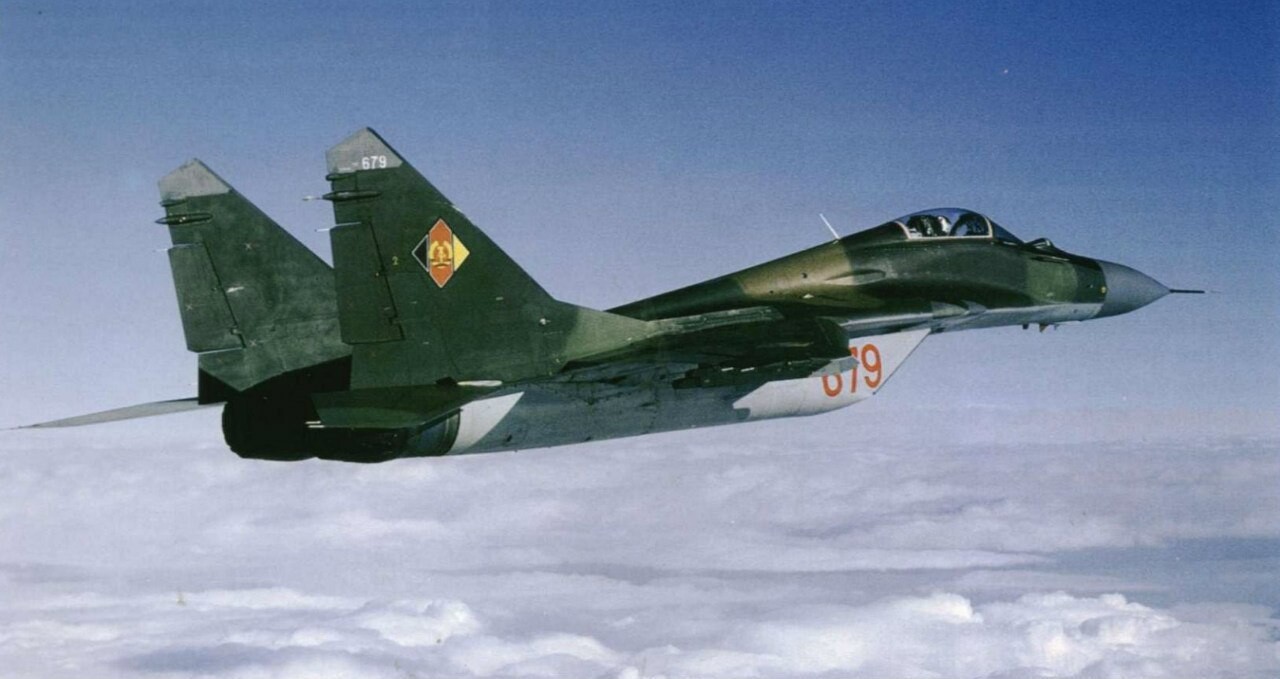-
Posts
1766 -
Joined
-
Last visited
Content Type
Profiles
Forums
Events
Everything posted by Top Jockey
-

investigating Thrust to weight ratio: confused
Top Jockey replied to bkthunder's topic in MiG-29 for DCS World
Regarding the Flanker's G limit I believe so, but then there's another side of the matter, which is : At another thread I've oppened (1 year ago or so) in the Russian ED sub-forum, roughly 90 % of the members said that the Flanker can maintain slightly more Gs than the Fulcrum at slower speeds... essentially because: " MiG-29 is a stable design, it's elevators acts opposite to wings decreasing it's overall lift, this increases AoA in turn (plane needs higher AoA for given G, thus bigger drag) and cause MiG to lose it's speed in turn faster than modern unstable designs like F-16 or Su-27. " (quoting @bies, from another thread) - so this can end up giving the Flanker a better corner speed, or turn rates, at certain speeds ? (Let's say, it can not pull 9 Gs, but probably at 330 kts it could pull more Gs than the Fulcrum at the same speed ?) -

investigating Thrust to weight ratio: confused
Top Jockey replied to bkthunder's topic in MiG-29 for DCS World
Yes, Very good already - and as I recall form talking to the Russian forum members, indeed the MiG-29A does have those characteristics; it does needed some speed to be able to maintain a good STR. (At that time my comparison was between the Fulcrum and the Flanker... which the later supposedly can pull a little more G's at lower speeds). Thank you @Ironhand, @Cmptohocah and @captain_dalan, So on those light weights and low altitude conditions, is it reasonable to expect in real life conditions that : The MiG-29A's maximum Sustained Turn Rate, could be roughly similar to the F-14A's (with its underpowered engines) ? - empty weights: the F-14A is almost twice heavier than the MiG-29A; - Thrust / Weight ratio: is better on the MiG-29A; - Wing loading: is better on the F-14A; - Lift coefficients (CL max): no idea which is better, I've read the MiG-29A's is supposedly 1.5 or something... Several people here have explained to me that I've probably over-valued the Fulcrum's BFM turning capabilities in real life, but I mean... does it at the least have a more advantageous corner speed than the Tomcat, or something ? -

investigating Thrust to weight ratio: confused
Top Jockey replied to bkthunder's topic in MiG-29 for DCS World
Hello @captain_dalan, 1. It would be time till fuel out, as I would prefer to have an idea of performance in very light airframes; 2. Sure - DCS data would be enough for me, as RL data on those very specific conditions might not always be at hand; (But, if you have RL data on similar conditions, that would be very good also.) 3. It's just a personal curiosity, as the max. degrees per second a given airframe can sustain always caught my attention. -

investigating Thrust to weight ratio: confused
Top Jockey replied to bkthunder's topic in MiG-29 for DCS World
Regarding @sylkhan prevous claims. On the Fulcrum's performance vs the Tomcat, I'll admit some curiosity of my own, as I do not have Tacview installed : - MiG-29A vs F-14A (TF30 engines) ; - guns only, no external payload or fuel tanks, for each ; - internal fuel quantity for roughly 3 - 4 minutes in full afterburner, for each ; - slightly above sea level. My doubt is purely: what would be each one's absolute maximum Sustained Turn Rate, in degrees per second ? ( I'm not asking about Corner Speed, or Instantaneous Turn Rate, or minimum turn radius, etc... ) Does anyone have an aproximate idea ? Thank you. -
I fully agree. It is the most complete / realistic one I've known so far. Without even going into the Full Fidelity modules, just taking the Flaming Cliffs 3's MiG-29 as an example - I don't know anyother sim where its flight model and interior cockpit graphics are so accurately portrayed.
-
For my VERY limited knowledge on those matters, that is a more complicated question. (Several physics matters interact here.) My perception is that for A-A missiles, the last remaining airspeed when intercepting a target, can be of even more paramount importance than its control surfaces design, why ? Because contrary to a fighter jet, most A-A missiles do require a somewhat high airspeed to be able to turn reasonably well, and also maintain altitude if needed. Most fighter jets, can maintain a slow turn even at less than 200 kts airspeed. Most A-A missiles, will be falling from the sky already quite before slowing to those speeds, (and much less would turn effectively). Without enough kinetic energy, there's no control surfaces which might help.
-
I suppose the AMRAAM's developers / contractors, were more interested in getting every bit of available "reach" out of it, and hence its relatively small wings / control surfaces to lessen the aerodynamic drag...
-
Hello, First - at the DCS Store site : https://www.digitalcombatsimulator.com/en/shop/ You purchase your modules, and follow the several necessary steps - (introduce your costumer info, register or login, purchase cart, payment, and whatever). Second - you login at DCS World : (with the same costumer info you created at the site) And at the in game menus you download / install / activate your desired modules... which you bought previously at the site.
-

How do you "balance" other modules with the Tomcat?
Top Jockey replied to Jayhawk1971's topic in DCS: F-14A & B
Interesting observation, but I cannot completely grasp its meaning... As with the TF-30 engines, the Tomcat always was considered underpowered. Perhaps you mean, you do prefer the added difficulty and peculiarities of dogfighting in an inferior Thrust / Weight ratio airframe ? -
By mere curiosity, got 9.3 G ( horizontal turn or down portion of the loop ? ) without much effort, if i recal correctly: - "very low" fuel; - no external stores / ordnance of any kind; - clean wingtips; - no gun rounds; - very close to sea level; - sharp pull on the stick with speed slightly above 450 kts.
-
The E variant is always interesting (for me essentially because of its internal M61 gun), but my favourites would be also: - US Navy variants; - Royal Navy F-4K Phantom FG.1 - this: https://forums.eagle.ru/topic/285899-phantom-fg1-f-4k/page/2/#comment-4823664
-

F14 ACLS and ILS do not match - shallow landing with ACLS
Top Jockey replied to bogusheadbox's topic in General Bugs
I can confirm. Also I'm not sure, but I believe that discrepancy has been around for a while. -

How do you "balance" other modules with the Tomcat?
Top Jockey replied to Jayhawk1971's topic in DCS: F-14A & B
BALANCE ? No balance : REALISM, for each and every module. As much as possible. Joking aside, I understand the OP's question. Tipically I spend the majority of my time with the Tomcat, and sometimes I interchange between Hornet or the Fulcrum. - on fewer occasions, I feel like taking the FIshbed for a ride... just to remember how it is to land it at roughly 300 kph in bad weather; - on others, the Viper or the Hornet to tweak with their JHMCS modes, various sensors, etc. Naturally I don't do it all the time, as one must adapt to each airframe's own switchology, controls, etc. -
After dealing with the only difficulty I had using the ACLS : - when selecting ACL at the AWL modes for HUD and VDI (right panel), sometimes the needles remained stuck... I've finally found the error in my procedures : - ACL needles don't work without the DATALINK activated. Another of the many Tomcat technicalities that I find interesting, as didn't have the slightest idea - I always thought having TACAN and ICLS correct channels / freqs selected was enough... it seems not.
-
Très bien !
-
Hello, Sure, I generically know both airframes and flight controls strenghts and weaknesses, the Hornet's high AoA capabilites, and the Viper's restrictions, etc. About the bold, @TobiasA mentioned "a heater fight". That's why I was thinking, the Viper could try forcing a 2 circle fight right from the merge, also cashing in some speed to try quickly gaining angles, and bring his nose to bear as soon as possible on that first turn...
-
Very interesting points. Some curiosities from my part though (as I'm a single player guy): 1. Even without the Hornet's pitch rate and high alpha capability, why can't the Viper also pull tight in his first run ? ... or are we talking in a 1 circle fight right from the merge ? 2. Which airframe can't beat the Flanker with R-73s ? Aren't the Viper or the Hornet with the AIM-9X be more than a match for the Flanker ? Why specifically the Flanker, and not also the Fulcrum ?
-
Well... the big cat still lives. For me there's kind of 'mixed feelings' seeing the vídeo. As if on the one hand it is sad to see the Tomcat as a mere 'shadow' of what it once was in its prime time... on the other i like to see that the 'legend' lives on. Noteworthy, the F-14A is on Iranian Air Force service at 44 years already... ( Reminds me Agentina Air Force, which kept their Mirage IIIEA's on service for 41 years. )
-
Not being me someone who remotely knows anything about programing, coding or whatever : I suppose, that USS John C. Stennis 74X TACAN code still appearing in 'triggered actions' is a remaining from previous DCS versions, which was not updated to the correct 59X with the USS Forrestal implementation in game. My point was merely, if sometimes this may cause some sort of conflict causing the TACAN to stop working.
-
@draconus, By any chance was this confirmed, or it doesn't have nothing to do with TACAN not appearing sometimes ? ( At quickstart / instant action, Forrestal case 1 recovery ; Mission Editor - Triggered Actions TACAN shows 74X, when Route TACAN shows 59X ... ) https://forums.eagle.ru/topic/284649-feedback-thread-f-14-patch-jester-lantirn-uss-forrestal-oct-20th-2021-hotfix-oct-28th/?do=findComment&comment=4823966
-
59X
-
Absolutely crucial ^
-
Hello, High WOD ? What is that ? edit wind over deck ?
-
Well, just for curiosity sake, after some experimenting: In-game it is possible to "trap" a hookless Tomcat... without it exploding or get severelly damaged. (Although in reality my experiment conditions would mean serious damage to the airframe / aircraft.) ... coming in very light, very slow, pulling the brakes right on touch-down, and finally colliding with hard static "cargo" objects at roughly 30 kts speed, on the very bow of the ship.
-
By mere curiosity I've been experimenting this... and it seems VERY difficult without destroying the aircraft. The logic (common sense) solution, would be the barricade net which will eventually be available for the Supercarrier. - rows of static objects on deck, like tires with flags, cows and even the flight deck tractors, seem to have little or no effect in stopping the Tomcat; (the cows do die, but the deck tractors seem to be ignored collision wise...) - on the other hand, wodden logs, "small" concrete barriers and even a canvas tent, will make the Tomcat explode when the nose gear collide with them ! - the main gears seem to be prone to get ripped, hindering that way the aircraft's motion; but a nose gear collision seems to cause fatal explosion.


